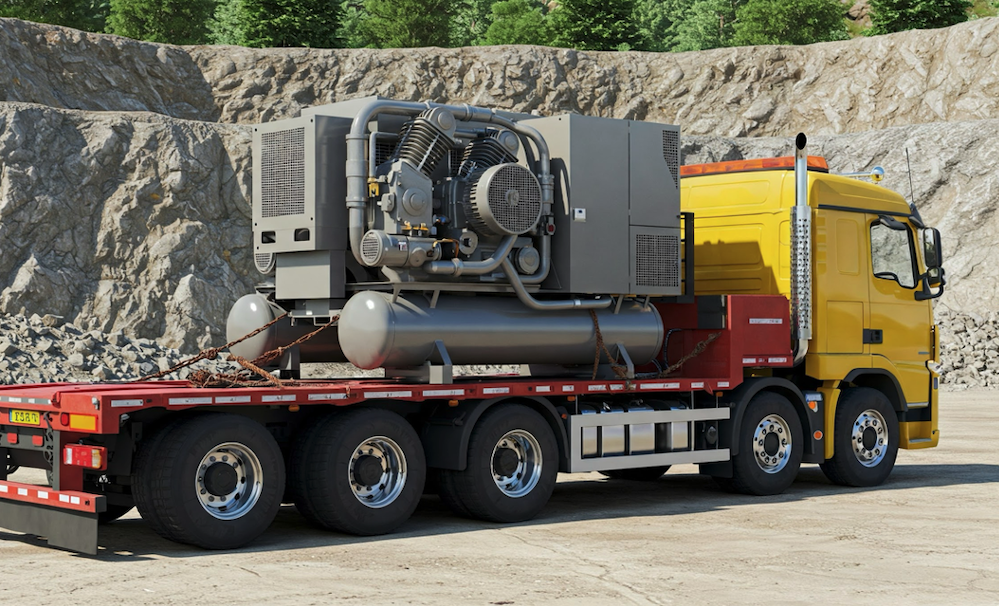On the tough terrain of haulage, air compressors are an absolute necessity. They power equipment, inflate tires, and keep essential systems humming.
As with any piece of haulage equipment, you need a solid understanding of safety protocol. When you’re hauling units down the road for miles, even state borders, safety becomes more critical than ever.
Let’s walk through some of the most critical areas to ensure your air compressor is secure and safe on the move.
First things first: Securing Your Investment
Imagine your compressor flying through the bed of your truck. Not only is it a formula for disaster, but it’s also dangerous. Proper securing is a must.
As with securing any valuable load, a solid, stable mount is the beginning. Bolted to the truck or trailer, make sure the compressor is as tight as possible.
Straps and chains are your best option here. Use heavy-duty rated chains or straps and double up to make sure that they’re securely fastened. An ill-secured compressor is an accident waiting to happen.
Here’s a tip: if your compressor is designed to stand up, do that. Putting it on its side, particularly oil-free models can lead to moisture issues in the future. Find the right air compressors built for optimal safety.
Inspection and Maintenance: Your Pre-Trip Ritual
Before hitting the road, make a habit of inspecting your compressor. Think of it as a pre-flight check for your haul.
Run your eyes over the fittings and hoses. Are there bulges, cracks, or leaks? Even a small leak can be big trouble.
Don’t forget about pressure relief valves. They’re your over-pressurization protection stops. Ensure they are functioning.
Check your drain valves too to drain accumulated moisture, preventing corrosion. And check your shutoff valves at all times for smooth movement.
Workspace and Ventilation: Breathing Easy
Even for transportation, ventilation is required. When your compressor is in operation, or even just stored in a compact space, there is room for heat buildup. Ventilation takes care of this, reducing the risk of overheating and fire.
Be careful with air intakes. Clear out exhaust gases and other contaminants. You don’t want your compressor breathing pollutants.
Don’t forget, water is the killer of metal components. Keeping your workplace bone dry will extend years of life on your equipment.
PPE: Safeguarding Yourself
The job requires the proper personal protective equipment (PPE).
Safety glasses are required in order to shield your eyes from debris. Hearing protection also needs to be available, as the compressors will be extremely loud. Gloves protect your hands from cutting edges and searing hot components.
Wear clothing that won’t get stuck on moving parts or high-pressure air exposure.
Compressed Air Hazards: Be Aware
Compressed air is strong and can hurt if used carelessly. Never, ever press an air nozzle up against yourself or another person. It will hurt you badly.
Realize compressed air can contain dust, oil, and other impurities, so always be aware of what you are spraying.
High-pressure air should not be underestimated.
Learn how to control the pressure safely so accidents can be avoided. Do not try to cut off airflow by bending a hose. Use the control valve whenever possible.
Finally, remember that compressed air is not breathable air. Inhaling it is extremely dangerous. Use it for its intended uses only.
Safety First
Use this guide as a checklist for your upcoming shift and include it in your employee manuals. Precautions for air compressor safety are part of employee health that increase productivity and prevent workplace injuries.
By adopting these safety habits, you can keep your air compressor in the best shape to have the safest, most effective equipment in your haulage operations. Stay careful, stay safe, and let that air flow smoothly.








